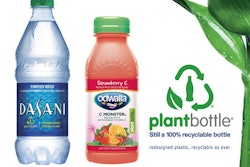More specifically, the trend is for private standards rather than legal requirements. Everyone, I exaggerate, is looking at you, kid.
The most recent and perhaps the most significant example is the announcement of the Global Food Safety Initiative’s decision to address food packaging. Inspired by stakeholder meetings in 2010 and 2011 that took a total supply chain approach to food safety, the group announced in early 2011 that it would form a packaging safety think-tank. The idea is to go beyond the focus on safe ingredients and safe production practices to encompass also packaging materials and handling, transport and distribution, and anything else that might affect safety.
GFSI is one of several influential international organizations, and though it’s not the first to address packaging as such, it is especially clout-heavy because in 2008 Walmart began to require many of its suppliers to meet the group’s standards. And its attention to packaging helps lead one to conclude that there is a widespread trend toward including packaging considerations when evaluating food safety.
What we are seeing precisely is a matter of extra emphasis on food packaging safety, because, after all, for as long as there have been “Good Manufacturing Practice” regulations from FDA, designed to assure the making of safe foods, there has been a recognition that packaging materials are part of the universe of relevant concerns.
The FDA’s food GMP regulations are organized into a series of headings that signal their broad scope: personnel; plants and grounds; sanitary operations; facilities and controls; equipment and utensils; processes and controls; warehousing and distribution. The processes and controls regulation describes the need to conduct packaging operations in accord with adequate sanitary principles, and to use safe and suitable packaging materials.
And while many makers and users of food packaging have employed longstanding practices designed to assure safety and compliance with law and regulations, the whole area is getting more attention now.
GFSI says it will be providing guidance to allow the evaluation of food safety management schemes. In particular, attention is going to be paid to nanoscale technology in packaging, though a spokesperson for the organization emphasized that the approach to nanomaterials will be dictated by “good science” not a desire to unnecessarily “exclude or promote [their] use.”
The idea is that GFSI will declare some food safety management plans to be effective, which will allow standardization of audits. “There is currently no single universally recognized food packaging manufacturing scheme, and as a result many packaging manufacturers have to undergo numerous audits based on different schemes, depending on the client requirements,” says GFSI in an interview.
Packagers will find this a familiar lament, as many are subjecting themselves to multiple international standards organizations and audits to satisfy different customer requirements. GFSI says that, “as audits against GFSI-recognized schemes are accepted by a large number of retailers, manufacturers and foodservice operators the world over, packaging makers will be able to benefit from GFSI’s harmonization efforts and work with their single preferred GFSI-recognized scheme, rather than having to meet a plethora of different requirements.”
Any international auditing and standards organization would love it if their schemes were more widely accepted, which would provide not only efficiencies for their customers, but increased revenues for their organizations.
Tim White, vice president of quality control for the rigid open top division of Berry Plastics Corporation, participates in GFSI. He says the new attention to packaging was motivated by the preceding increase in allergen and labeling problems leading to product recalls, as well as the proliferation of differing packaging standards. He agrees that there is additional attention on packaging safety and control. “I definitely think it’s a trend,” he says.
He adds, “In looking at the increase of food recalls, I think the data shows that packaging (in which I include labeling) also has spiked greatly over the years. In the last 5 years I have seen changes to standards, adding additional requirements for packaging etc. due to the continued increase. Allergens are not just limited to the standard ‘major allergens’ recognized by US law that we all read about. Packaging and labeling can definitely cause allergen issues and people are really now just truly understanding how important controlling packaging can be.”
Also part of the trend toward providing methods to enhance packaging manufacturing control is the Food Safety Alliance for Packaging, a committee of the Institute of Packaging Professionals. [The author is a board member of FSAP - Ed.] That group’s first major action, published in 2009, were models to allow packaging makers to impose Hazard Analysis and Critical Control Points plans in their operation. Not surprisingly, control over allergens is a recurrent theme in those models. (See www.packworld.com/article-29498 for more information.)
So be aware, food packaging makers: increasingly, you are being watched.























